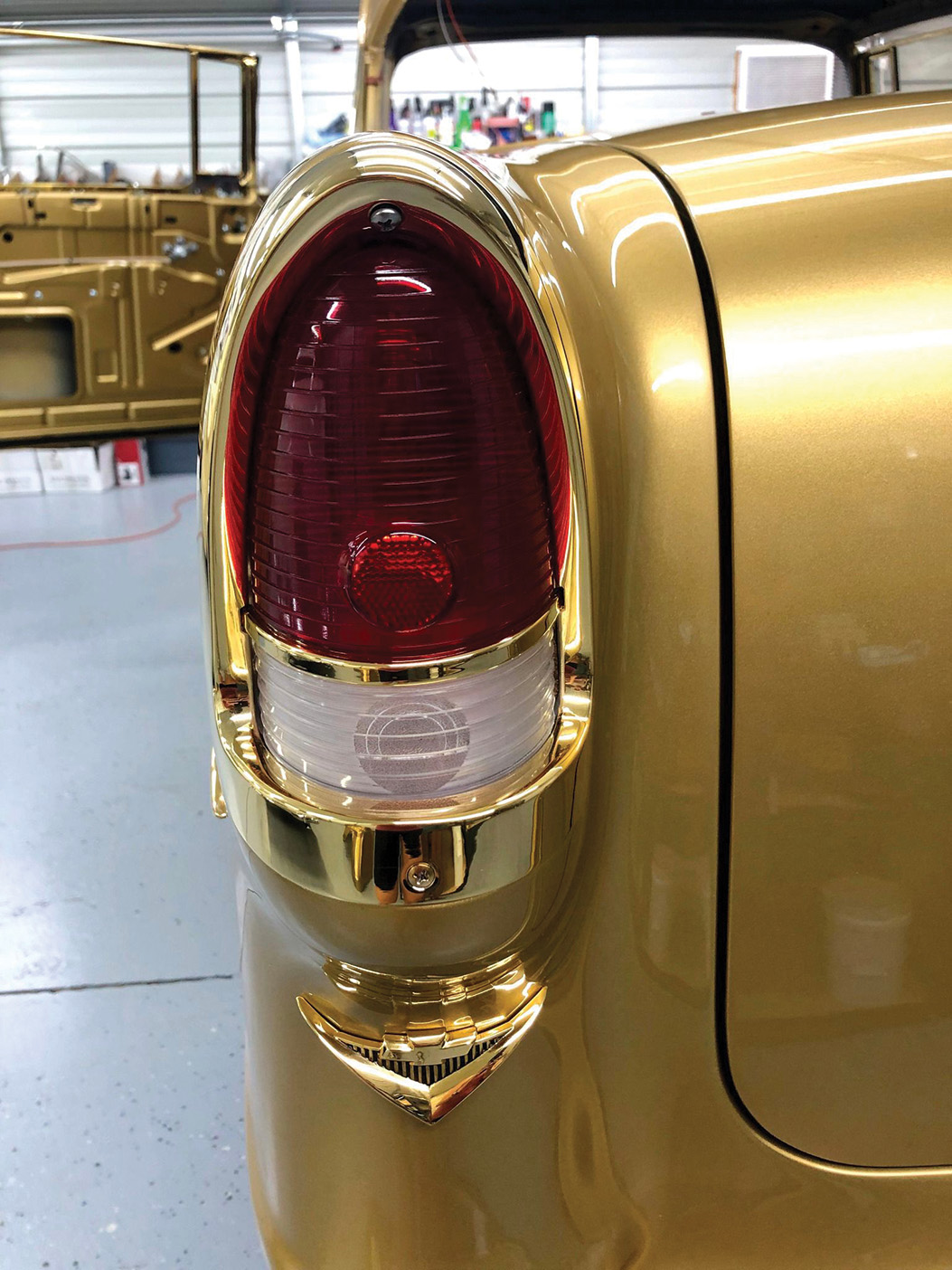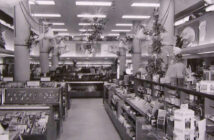On a clear, sunny day in Downtown Flint, a crowd over 200,000 strong had gathered along the length of Saginaw St. They covered the sidewalks, hung out of windows and stood on rooftops in anticipation of celebrating one of Vehicle City’s biggest achievements. They came to witness history. That day, November 23, 1954, the 50-millionth General Motors car was completed in Flint at 9:50 AM, signaling the start of GM’s nationwide “Golden CARnival” celebration. At approximately 10:10 AM, GM opened 125 GM plants and training centers across the country to the public and hosted luncheons for business leaders in 65 cities.
In Flint, the city of its birth, GM’s plan for celebrating was more grandiose. To mark the momentous occasion, a mile-long parade was held that featured nine bands, 18 floats and 72 1955 GM vehicles. It began at 11 AM at S. Saginaw and Court St. and concluded at N. Saginaw and Fifth Ave. – the IMA Auditorium. The crowd cheered and bounced to the music of the marching bands, laughed at the dancing AC Spark Plugs, and reveled in the new vehicles that they themselves had made. Near the end of the parade came the float holding the 10-millionth car and then, the 25-millionth. The crowd craned their necks looking down the street in an attempt to glimpse the next float before their neighbors and friends did, all wanting to claim it was they who saw it first. When the 50-Millionth car appeared, the crowd was awestruck. They gasped as the golden 1955 Chevrolet Bel Air Sport Coupe floated by. For many, it was the most wondrous thing they had ever seen or ever would see. As it continued its path down Saginaw St., it rolled closer to future infamy and legend …

The 50-Millionth GM car represented the absolute pinnacle of the City of Flint. As the perfect representation of Flint’s manufacturing prowess, it represented the status of the city in a day when Flint was the center of the universe. It shined. Unknown to the cheering crowd, it also marked the last celebration of the strength of the General Motors and Flint relationship. The car became a symbol of Flint at the top of its game and, like the Vehicle City itself, soon became lost to the trappings of time. The car quickly disappeared and was forgotten in all but myth.
Until now.
Joe Whitaker, co-owner of Real Deal Steel in Sanford, FL has been a car guy his entire life. His interest lies with all classic cars but he holds a special fondness for 1955, ’56 and ’57 Chevrolets. Above all, the Golden Chevy always stood out in his mind. The legend of the car found him when he was 15 years old. “I heard of the myth of the Golden Car and I saw pictures of it back in the day,” Whitaker remembers, “but I never put much thought into where it ended up or even about restoring it.” He was perfectly fine with letting the car remain in history until a friend called him to share an interesting find. “He told me he had a pair of golden windshield wiper blades that he purchased from the old Trico factory in Buffalo, NY,” he says. “It turned out that they were an extra set made in 1954 for the Golden Car project. That got me interested.” After that conversation, Whitaker couldn’t get the car out of his mind and soon thereafter, broached the subject with a friend of his from Kentucky, Steve Blades. “He and I had a lot in common. I brought up the Golden Chevy in conversation and of course, he’d heard of it,” Whitaker recalls. “I told him I knew of a set of wiper blades that were made for it and he couldn’t believe it.” Upon learning of their existence, Blades decided he had to have them. Whitaker made a phone call and $3,500 later, the wiper blades were in his hands. “I decided then that somebody needed to let the world know about them – somebody had to know about this car and it should be restored,” he states.
“We decided there that we would build a car – a tribute to the original. Steve (Blades) has a huge collection of used parts and Real Deal Steel would supply the body. Snodgrass was willing to do the build. It would be as close to the original as we could possibly make it.”
Joe Whitaker, Co-Owner, Real Deal Steel
Blades and Whitaker both looked into the legendary car’s history and found out that the current owner lived in Columbus, NC; but there was a problem. The original car burned in a garage fire in 1996 and the only things remaining were a few parts and the interior. Undaunted, Whitaker called Dave Snodgrass from Snodgrass Chevy Restoration in Melbourne, FL to ask if he would be interested in the project if Whitaker could acquire what was left. “Dave, his brother Kenny and Michael Wisenewski are the best in the business at Chevy restoration,” Whitaker says. “They do great work and when I asked, they were ready to go without hesitation.” He called the current owner and made him an offer. “I offered $100,000 for the remains of the car,” he says. “I was turned down immediately. There was nothing I could say or do.”

The brakes were put on the project.
Still, Snodgrass, Whitaker and Blades believed that the restoration of the Golden Chevy needed to be done. It simply had to happen, with or without the original parts. “Everyone involved in the idea met in April 2023 at the Charlotte (NC) AutoFair,” Whitaker says. “We decided there that we would build a car – a tribute to the original. Steve (Blades) has a huge collection of used parts and Real Deal Steel would supply the body. Snodgrass was willing to do the build. It would be as close to the original as we could possibly make it.” The group sprang into action.
While the guys at Snodgrass and Real Deal Steel got to work, Blades dove deep into research. He contacted General Motors and received pictures (some never seen before) of the 1955 Golden Chevrolet and last August, made the journey with Whitaker to Flint for the first time to pore over the archives at the Sloan Museum. What he found while languishing over photos and newspaper articles was astounding. “At first, I second-guessed myself a little bit,” Blades laughed. “What I found, eventually, was that there wasn’t just one gold car. There were three.” Yes – GM built three separate and distinct Golden Chevrolets.
“As I was looking at promotional photographs of the car sitting next to the 25-millionth from GM, I realized that it was dated October 28, 1954 but the actual 50-millionth car was built in November,” Blades continues. “I started looking closely at more photos and what I found was that the car in the October photo was uniquely different from the car at the parade.” Blades noticed that the cars differed in many ways: 1. The one in the promotional photo which Blades calls Car #1 or “The Motorama Car” has distinct rear paint dividers that the parade car (Car #3) is lacking. 2. Through photographs, Blades figured out that Car #1 had power steering, A/C and power brakes and windows, and the parade car did not. 3. Car #1 has a radio (but no antenna) while Car #3 sported the radio block-off plate, but no radio. 4. Car #1 was fashioned with Goodrich tires while Car #3 had U.S. Royal tires, and the differences kept becoming apparent. “I was shocked!” Blades exclaims.
Absolutely sure that GM made two cars, Blades was surprised again when he viewed the “Achievement USA” video (available on YouTube) created for the Golden CARnival. What he noticed is that the car depicted on the assembly line in the film is different from the two he previously found. Car #2 (or “The Movie Car” according to Blades) only appeared in two promotional items – “Achievement USA” and a single promo photo accompanied by two female models. “I went over the video frame-by-frame and realized that Car #2 had a smooth vinyl interior, not pleated like Cars #1 and #3 had,” he explains. “Car #2 appears not to have gold-plated trim like the other two.” After careful examination, Blades found even more differences which led him with confidence to state that three cars were built. GM reps were astounded with his findings. No internal records of three vehicles exists.

Blades posits that Car #1 was most likely built in early October for promotional purposes. This is the car that was purchased and then burned in a North Carolina garage fire. Car #2, according to Blades, was presumed sold to a private purchaser but its true fate is unknown. Car #3’s whereabouts is also unknown, but Blades has an idea where it could have gone. “It was most likely taken to a salvage yard and disassembled,” he remarks. “In my opinion, Car #3 (The actual 50-Millionth car) was never meant to be driven. In fact, it was believed that at the end of the parade, it was driven to the stage at the IMA Auditorium; but when looking at pictures of the car on stage, it’s obvious that the car there is Car #1. Car #3 never made it off the float.”
“We were all excited to find out that there were three cars made,” says Whitaker. It wouldn’t be the last surprise for the team when weeks later, they made another discovery. Hoping to get pictures of the interior of the car that was located in NC, Whitaker had plans to show up to the owner’s house and offer anything he could to gain entry. As he was about to make the trip, he was informed by Blades that the family of the owner was offering old Chevy parts for sale on social media. “I was planning on going to the house anyway,” says Whitaker. “It was perfect timing.” What he found there were original parts of Car #1! “After the car burned, the original owner chopped up the body and discarded pieces throughout his property,” Whitaker says. “We found the grill, hood bird, armrest and pieces of the body!” None of the parts will be used to build the tribute vehicle; instead, they will be displayed alongside.
As the build went on, the story grew and more and more people showed interest and looked to participate. Sponsors offered to help with certain aspects of the vehicle and other tributes to the project were made. One friend finished a perfect replica model train of the one shown in the “Achievement USA” film and another friend from California is putting the finishing touches on a diorama of Saginaw St. representing the day of the 1954 Golden CARnival. Both will be displayed with the finished 50-Millionth Golden Tribute car at its debut at the Detroit Autorama Car Show in March 2024.
The finished car will include over 300 24k-gold-plated parts and will feature an all-golden chassis, drivetrain, body and interior. In a lucky coincidence, the car’s interior will also sport the fabric that was used for the original upholstery. “We contacted a supplier in Arizona who specialized in classic interiors and they were able to find the material used by GM for the special interior used for the Golden Car,” Whitaker smiles. “People will finally be able to see almost exactly what the car looked like as it was built on November 23, 1954.”
The project was inspired by a sense of duty – to pay homage to a legendary car and piece of United States history. What the project has become is something more. “It’s grown beyond us,” Whitaker says. “It has exploded into quite a thing and we believe that when it is unveiled at Autorama, attendees will be awestruck.”
For everyone involved, the project is more than a car. It is about a city and a moment in time. “When we came to Flint,” Blades recalls, “we walked the parade route down Saginaw St. We were given a nearly six-hour tour of Flint’s history by lifetime resident Daniel Bower and at the end, Joe [Whitaker] and I didn’t want to leave. You can’t talk about the Golden Car without talking about the parade or without talking about Flint and all it has meant to the country.” Whitaker adds, “Flint is a different city than what people think it is. The outside world doesn’t understand what Flint meant or what a huge deal the Golden Car was, what it meant to the world.” In Vehicle City, Blades found yet another mission. “We can’t thank the people of Flint enough – everyone has been so nice and welcoming,” he smiles. “We want to do something good for Flint.”
“We can’t thank the people of Flint enough – everyone has been so nice and welcoming. We want to do something good for Flint.”
Steve Blades
The 50-millionth Golden Car, like the city of its birth, is coming back. It’s being built from the ground up as a salute to what Flint used to be and a promise of what Flint is becoming once again. The Golden Chevy tribute car will make its public debut on March 1 at the 71st Annual Detroit Autorama at Huntington Place/Cobo. In June, the Golden Tribute team hope to bring the car back to Flint for the Sloan Museum Auto Fair. Keep an eye out for future announcements.
The Golden Tribute Car Project is: Steve Blades, Snodgrass Chevy Restorations (Dave and Kenny Snodgrass, Michael Wisnewski) and Real Deal Steel (Joe Whitaker, Randy Irwin, Jordan Sechrest).
The Golden Tribute Car Project would like to thank sponsors for all of their donations and help: Golden Star Classic Auto Parts (TX), Shafer’s Classic Reproductions (FL), American Autowire (NJ), Auto City Classic (MN) and Gene Smith Parts (CA).
If you have memories or photographs to share of this special car, the parade, the people or anything related to that day, please reach out to Steve Blades via email at rodshop57@gmail.com.















